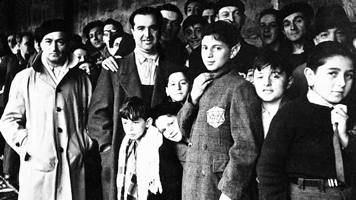
|
The Society of Folk Dance Historians (SFDH)
The Holocaust
[
Home |
About |
Encyclopedia | CLICK AN IMAGE TO ENLARGE |

|
The Holocaust dispersed the surviving Jews of Europe. Many immigrated to the British Palestine, hastening the founding there of the state of Israel. Contemporary Israeli dancing began in Israel as an effort to build a national identity in the new state.
Following World War II, the international folk dance movement in the United States grew rapidly in numbers and in a desire to expand its repertoire to include overlooked countries such as Israel. The new Israeli dances also added tremendously to the variety of music and physical movement in the international folk dance repertoire. The Israeli dances largely did not require partners, making them particularly attractive to people who did not have regular partners and starting the shift in international folk dancing away from couple dances.
 Displaced European Jews moved also to countries around the world, establishing or strengthening Jewish communities in those countries. The dances created to establish an Israeli national identity found fertile ground in these far-flung Jewish communities. The sheer size of the market enabled countless composers, lyricists, and choreographers to create material for Israeli dance, giving the international folk dance community a larger selection of dances to choose from.
Displaced European Jews moved also to countries around the world, establishing or strengthening Jewish communities in those countries. The dances created to establish an Israeli national identity found fertile ground in these far-flung Jewish communities. The sheer size of the market enabled countless composers, lyricists, and choreographers to create material for Israeli dance, giving the international folk dance community a larger selection of dances to choose from.
The unimaginable destruction caused by the Holocaust erased huge swaths of human memory, making historical research difficult, and frequently impossible. For a very small example of a near-loss of history, consider the case of the dance Yugo. Before the war, American Zionist Youth danced a dance called Heney Lo Yanum. Somehow, this dance came to be danced by Yugoslavs in a displaced persons internment camp in Belgium in 1945, where dance leader Huig Hofman discovered it. No one knew its name or origin, so Huig called it Yugo, a Yugoslav dance. For more information about this dance, see Hineh Lo Yanum and Yugo in the 2002 Folk Dance Problem Solver.
The Israeli dance movement introduced a novel form of social dance to many people around the world who would not otherwise have tried it. I speculate that some of these people then sought further novelty the international folk dance movement, swelling its numbers in the post-war years.
The Holocaust also reminded people of the Armenian genocide of their parents' and grandparents' generations. Accordingly, Armenian dances also experienced a resurgence among international folk dancers, further increasing the proportion of non-partner dances.
DOCUMENTS
- Armenian Question, an article.
- Belgium, a country.
- Europe, a region.
- Folk Dance Problem Solver, a publication.
- Israel, a country.
- Jews, a culture.
- Palestine, a region.
- Ron Houston, an article.
- United States, a country.
This page © 2020 by Ron Houston.
Please do not copy any part of this page without including this copyright notice.
Please do not copy small portions out of context.
Please do not copy large portions without permission from Ron Houston.